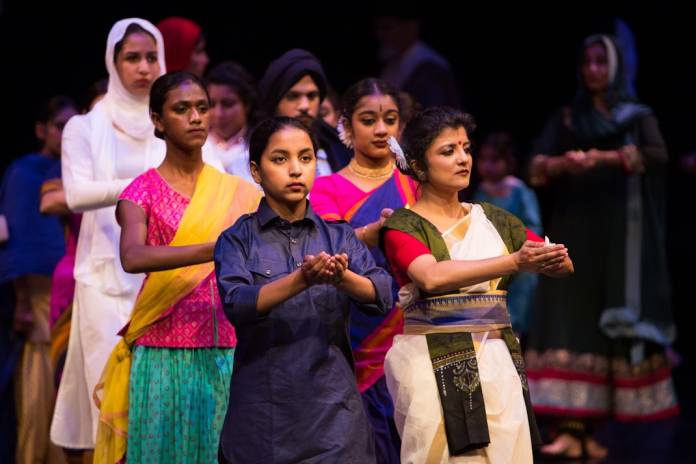ONSTAGE The crowd of weary travelers staggered on stage—some in elegant jewel-toned salwar khameez and saris, some in ragged dhotis and shawls. They carried bedding, a battered trunk, a sewing machine, a baby. Exhausted and bewildered, they seemed to be going in circles, unsure of their destination.
Behind them, a map of colonial India, dense with villages, was projected on white sheets hanging from a line.
A British bureaucrat in a suit, clutching a map in one hand and a long pointer in the other, smacked his pointer at the map and the travelers scattered, some to one side of the stage, some to the other, careening, pushing and falling over each other. He struck his stick again, and again they fled haphazardly across the stage, seeking safety.
The cause of their anguish? The Partition of 1947—the British division of India and Pakistan —which created “the greatest walking migration of the twentieth century.” That was the subject of The Parting, produced by EnActe and Nooorani Dance earlier this month at Z Space. (It comes to San Jose’s Hammer Theater March 23 and 24.)

With cold regard for ancient traditions, village friendships, or families, the British divided the land along religious lines—forcing Hindus out of Pakistan, Muslims out of India. Cyril Radcliffe (Stefan Fisher), the Englishman creating the arbitrary and cruel boundaries at the behest of Lord Mountbatten, was not a cartographer and had never been to India—but his hasty decisions displaced 15 million people and caused the death of an estimated 2 million.
Writhing on the stage, the travelers moaned and cried, “Why remember? Some things are better left forgotten…”
But a small orphan girl Asha (Anika Warrier) begs her adopted grandmother Mamta (Ranjita Chakravarty) to tell her what happened to all these grief-stricken people. Mamta reluctantly agrees, explaining that she has to go back in time “to when the line was fresh in the sand, like a wound that had just begun to bleed.”
Each of the 15 million had a story, and the breadth and depth of those personal stories is what playwright/director Salil Singh brings to the stage in The Parting. The stories, all based on real events, were developed for the drama by Anurag Wadehra from newspapers, archival research, and oral histories. Singh forged them into this ambitious production, which dares to “awaken the pain and tear things apart.”
Help us save local journalism!
Every tax-deductible donation helps us grow to cover the issues that mean the most to our community. Become a 48 Hills Hero and support the only daily progressive news source in the Bay Area.
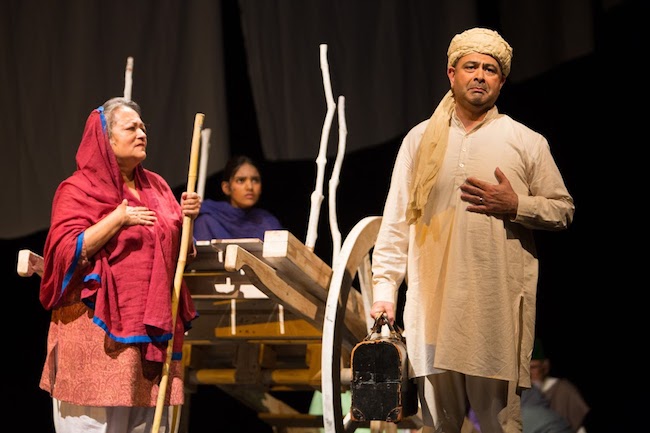
As Mamta shares the painful history with her young listener, they ride a primitive wooden cart, the centerpiece of the stage design by Salil Singh. The cart also serves as a metaphorical vehicle, traveling through time, locations, and sorrows.
In one vignette, Boota, a Sikh peasant (Chanpreet Singh) rescues Zainab (Farah Yasmeen Shaikh), a Muslim refugee who is brutalized by thugs. He shelters her with tenderness and respect, and they eventually fall in love, marry, and have a daughter. But their tragic past is resurrected when, after the passage of the Abducted Persons Recovery Act, Zainab is forcibly returned to her home village in Pakistan and torn from her husband and child.
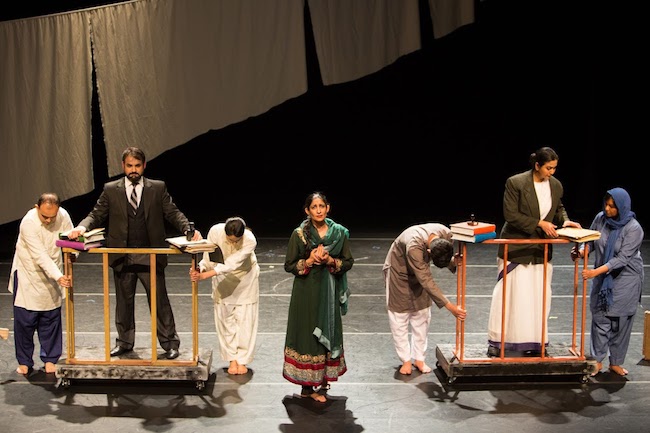
In another tale, the hapless Ghulam Ali, (played with comic undertones by Chinmaya Vaidya), a limb-fitter in the British army, is trapped between the two new nations. The Pakistani authorities throw him out because he was born in India, the Indians deport him because he is Muslim. He is shunted back and forth across the border and, like so many others, becomes a man without a country.
The production director, Vinita Belani, founding artistic director of EnActe Arts, a company dedicated to presenting South Asian stories to theater audiences, undertook a challenging task: staging this epic with 22 actors (many of them children) and 18 dancers.
The dancing was especially evocative—both the ensemble pieces and the solos. Farah Yasmeen Shaikh, the dance and music director, brilliantly incorporated multiple forms of south Asian dance, both classical and folk, focusing prominently on Kathak, which originated in North India, site of the most brutal conflict during the Partition.
In one of the most effective uses of dance, two lines of women dressed in black with gunghroos—ankle bells often used in Kathak dance—surrounded the seated travelers. Their costumes evoked the image of a sooty train car, and the insistent rhythmic jangles created by their precise foot movements mimic the wheels of the train.
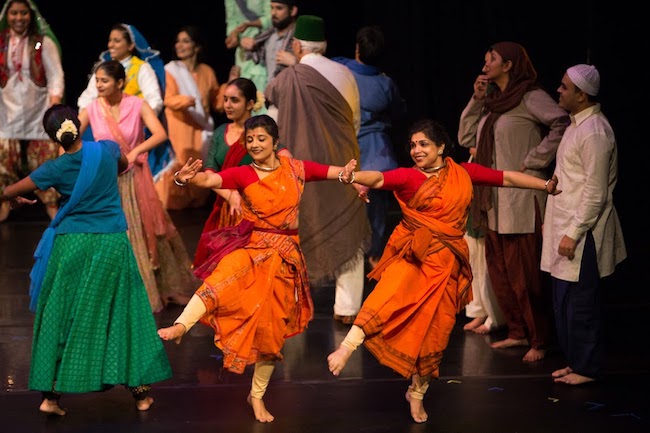
But the most exquisite dancing was Shaikh’s own solo as Zainab. When she relived her anguish through tortured movements, her portrayal of pain was breathtaking. As she emerged from her terror under Boota’s tender care, her graceful dance was as fluid as liquid mercury. In a later scene, when Zainab has to denounce her husband in court, her movements were sharp and jagged, almost as if she was cutting herself off from her past love.
The solo violinist Raaginder Singh Momi was another standout. His original compositions are based on Indian classical, folk, ghazal, and contemporary cinema styles. His onstage renditions of South Asian melodies were poignant and beautifully executed.
Unfortunately, some of the recorded background music used in the dance and ensemble scenes was not technically up to par, and often detracted from the elegant movement on stage.
The epic unfolds on a simple but visually compelling set, created by Singh. The white sheets hanging on a line divide the stage into the known and unknown, the perfect backdrop for the constantly displaced persons who shuttle from home, to road, to train, to refugee camp, and sometimes home again.
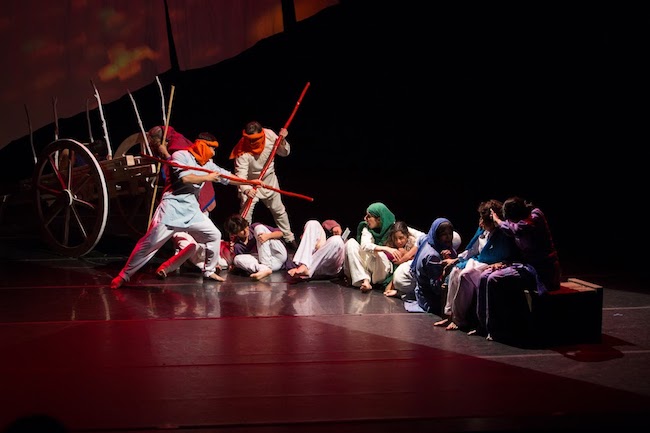
To present such a difficult history on stage is a challenging task, and the creative team strived to make it both understandable to universal audiences, and deeply credible for those whose families lived through it. Sometimes the challenge proves too much. With so many stories strung together the power of the key ones was diminished. Yet if some of the drama seems muddled or repetitive, the overall impact was powerful: Director Singh succeeds in portraying both the broad sweep of history, and the personal toll that it took on individual Muslims, Hindus and Sikhs.
In a particularly haunting scene, mobs massacre refugees on the trains heading both north and south. Survivors on both sides of the Partition ask the same question, “Will the nightmares ever end?” Producer Belani notes that unlike the Holocaust or Hiroshima, this tragic story is rarely told. Yet the wounds of this brutal Partition still scar both nations.


